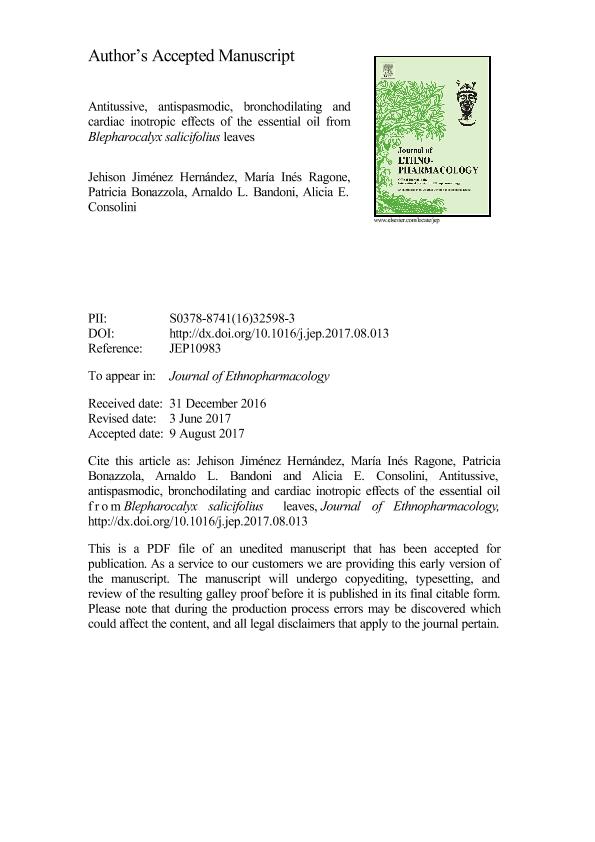Artículo
Antitussive, antispasmodic, bronchodilating and cardiac inotropic effects of the essential oil from Blepharocalyx salicifolius leaves
Hernández, Jehison Jiménez; Ragone, María Inés ; Bonazzola, Patricia
; Bonazzola, Patricia ; Bandoni, Arnaldo Luis; Consolini, Alicia Elvira
; Bandoni, Arnaldo Luis; Consolini, Alicia Elvira
 ; Bonazzola, Patricia
; Bonazzola, Patricia ; Bandoni, Arnaldo Luis; Consolini, Alicia Elvira
; Bandoni, Arnaldo Luis; Consolini, Alicia Elvira
Fecha de publicación:
01/2018
Editorial:
Elsevier Ireland
Revista:
Journal of Ethnopharmacology
ISSN:
0378-8741
Idioma:
Inglés
Tipo de recurso:
Artículo publicado
Clasificación temática:
Resumen
Ethnopharmacology relevance: Blepharocalyx salicifolius (Kunth) O. Berg (Myrtaceae) is a tree native to Argentina and Uruguay that grows and is cultivated along the riverside of the Rio de la Plata. The leaves of this plant species, locally known as “anacahuita” are used in South America to prepare infusions for the empiric treatment of cough and bronchospasm, as well as diarrhoea and other intestinal disorders. Although previous phytochemical studies have been performed with the essential oil extracted from Blepharocalyx salicifolius, pharmacological evidence supporting its traditional use is still lacking. Aim of the study: To experimentally evaluate the pharmacological properties of Blepharocalyx salicifolius based on its traditional use. The studies were performed with tincture (T-Bs) and essential oil (EO-Bs) prepared from its leaves, in isolated rat trachea, intestine and heart preparations. Methods: The ex-vivo effects of T-Bs and EO-Bs were evaluated with the agonists carbachol (CCh) and calcium chloride (Ca2+) in the contractile concentration-response curves (CRC) of the isolated intestine. The muscle relaxant effect of EO-Bs was evaluated in the isolated trachea and compared with the effect achieved with papaverine as a positive control. The T-Bs and EO-Bs cardiac effects were analysed by perfusion of an isolated rat heart before a period of ischemia/reperfusion (stunning model). The antitussive effect of both T-Bs and EO-Bs was evaluated in mice exposed to ammonia using codeine as a positive control. Results: Both T-Bs and EO-Bs induced a non-competitive inhibition of the CCh-CRC in the rat intestine, with IC50 values of 170.3 ± 48.5 µg T-Bs/mL (n = 6) and 5.9 ± 1.6 µg EO-Bs/mL (n = 6), respectively. EO-Bs also inhibited non-competitively the Ca2+-CRC, with IC50 value of 1.8 ± 0.3 µg EO-Bs/mL (n = 8). A similar effect was obtained with the main active component of the EO-Bs 1,8-cineole. In isolated trachea, EO-Bs induced the relaxation of the CCh-contracted tissue (1.7 ± 0.2 µg EO-Bs/mL, n = 11) up to a maximal relaxation that was 1.9 times higher than that of papaverine. In the isolated heart, EO-Bs induced a poor negative inotropic response, and did not improve the contractile and energetic recovery after ischemia and reperfusion. In the mouse cough model, EO-Bs (90 mg/Kg) was as effective as codeine (30 mg/Kg) in reducing cough frequency. Conclusions: The results indicate that the preparations from Blepharocalyx salicifolius leaves were effective as central antitussive, bronchodilating and antispasmodic agents, suggestive of a mechanism associated with the inhibition of Ca2+ influx into smooth muscle. The EO-Bs displayed only a poor ability to reduce cardiac inotropism, and was devoid of any cardioprotective properties. Thus, the present study validates the traditional use of this South American plant for asthma, cough and bronchospasm, shedding new light into its potency and putative mechanism of action.
Archivos asociados
Licencia
Identificadores
Colecciones
Articulos(CCT - LA PLATA)
Articulos de CTRO.CIENTIFICO TECNOL.CONICET - LA PLATA
Articulos de CTRO.CIENTIFICO TECNOL.CONICET - LA PLATA
Articulos(ININCA)
Articulos de INST.DE INVEST.CARDIOLOGICAS (I)
Articulos de INST.DE INVEST.CARDIOLOGICAS (I)
Citación
Hernández, Jehison Jiménez; Ragone, María Inés; Bonazzola, Patricia; Bandoni, Arnaldo Luis; Consolini, Alicia Elvira; Antitussive, antispasmodic, bronchodilating and cardiac inotropic effects of the essential oil from Blepharocalyx salicifolius leaves; Elsevier Ireland; Journal of Ethnopharmacology; 210; 1-2018; 107-117
Compartir
Altmétricas



